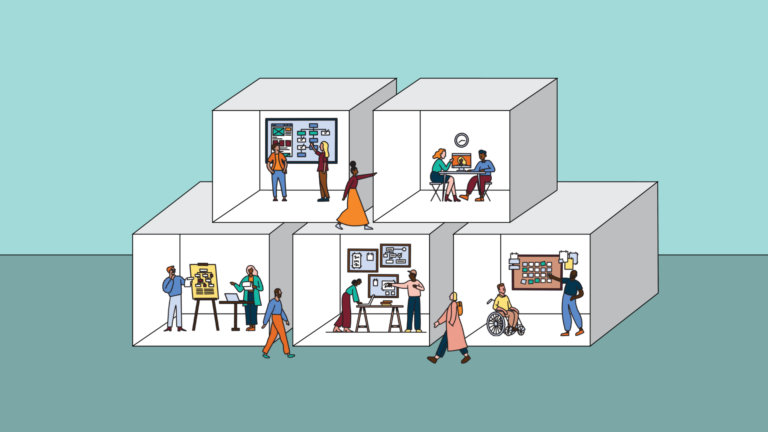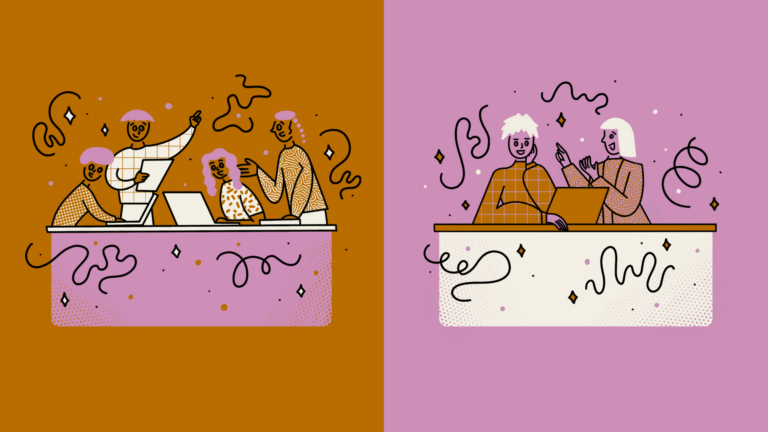Organizations are constantly navigating a landscape of change. In particular, many businesses face the complex challenge of balancing demand and capacity. How do you shuffle around resources, assign and manage people, and save time, money, and effort on your projects?
We’ve been working with many companies facing these challenges and we’ve seen some common pain points emerge.
- Difficulty maximizing existing talent—leaders know their team has bandwidth, but the project still doesn’t feel efficient
- Concerns about work being done on time or quickly enough
- Struggling to effectively prioritize work within the team
- Trouble maintaining quality with a team that is spread thin
These problems are widespread and can affect any team. In our experience, DesignOps is the key to solving these issues.
What is DesignOps?
DesignOps (short for Design Operations) is a methodology for establishing processes and implementing scalable solutions that maximize efficiency and quality on design projects. It includes a set of practices, workflows, and tools with the specific goal of streamlining design activities, enhancing collaboration, ensuring that projects are running efficiently, and producing quality experiences and products.
The Fundamentals of DesignOps
DesignOps is made up of three fundamental elements: people, process, and tools.
People
Focusing on the people element of a team includes examining skill development, team structure, and team management. This is where you clearly define team roles, including defining your project’s stakeholders—who are the deciders vs. the influencers?
Process
When looking into your processes, estimating work and managing capacity appropriately are vital to ensuring your project’s success. Who’s busy? When is the work due? Do you have time to do the work and maintain a high standard of quality? And if not—how else should you do it? When looking into your processes, estimating work and managing capacity appropriately are vital to ensuring your project’s success.
Tools
Are you using the best tools for your team and project? Can everyone on your team access them? Do they facilitate collaboration and make information readily available? Look at what you already have in-house and be open to bringing in a new tool that could help your process. Good tools will help make your team’s work more visible, collaborative, and transparent.
How can DesignOps help?
DesignOps addresses 4 challenges that stand in the way of smooth operations and efficient project delivery.
Developing a clear plan.
A good plan is one that is well-defined and actionable. Without it, projects can quickly lose direction. DesignOps helps set clear goals and milestones for the team and keeps a pulse on business objectives to ensure that the plan is aligned with the broader business strategy. As project plans take shape, assets like roadmaps and gantt charts provide helpful visual representations of the work that needs to be done.
Prioritizing team work.
Do you find it difficult to figure out which tasks and projects should be tackled first—especially if multiple stakeholders and departments are involved? DesignOps helps define prioritization criteria, taking into consideration factors like project urgency and stakeholder opinions. This helps teams make informed decisions about where to place their focus, reducing confusion and inefficiencies.
Implementing a clear operational model.
Inefficiencies and errors are symptoms of a disorganized workflow. DesignOps helps alleviate confusion by defining and implementing repeatable and scalable processes for all phases of design: research, UX strategy, content strategy, UX/UI design, and UX writing, to name a few. DesignOps ensures that all roles and responsibilities are mapped to each part of the product design process so that there are clear owners and decision makers as well as defined space for reviews with stakeholders to keep the work moving forward. Let our team of experts help you incorporate designops.Is your organization starting a product design project?
Using estimation and planning to set expectations.
With careful planning of the available resources like time, funds, and personnel, DesignOps helps set appropriate deadlines and expectations for stakeholders while also balancing priorities and taking note of team capacity and relevant skill sets. DesignOps works to create a system where statuses, timelines, and any potential delays are clearly communicated to stakeholders, which helps build trust and collaboration.
Having solutions for these issues creates space for leadership to grow the business and allows designers and other team members to focus on their work.
Putting DesignOps into action
We’ve helped countless organizations develop and implement a practical DesignOps model.
A client came to us with the dream of modernizing its suite of digital platforms and improving its member feedback process. Using our DesignOps expertise, we helped them prioritize their projects across several workstreams and build flexibility into their design process during the largest technological overhaul in the history of the organization. These methods allowed for rapid prototyping for user testing, which ultimately helped our client bring innovations to market faster than ever before.
Is your organization starting a product design project? Chat with our team of experts about improving your DesignOps today.



